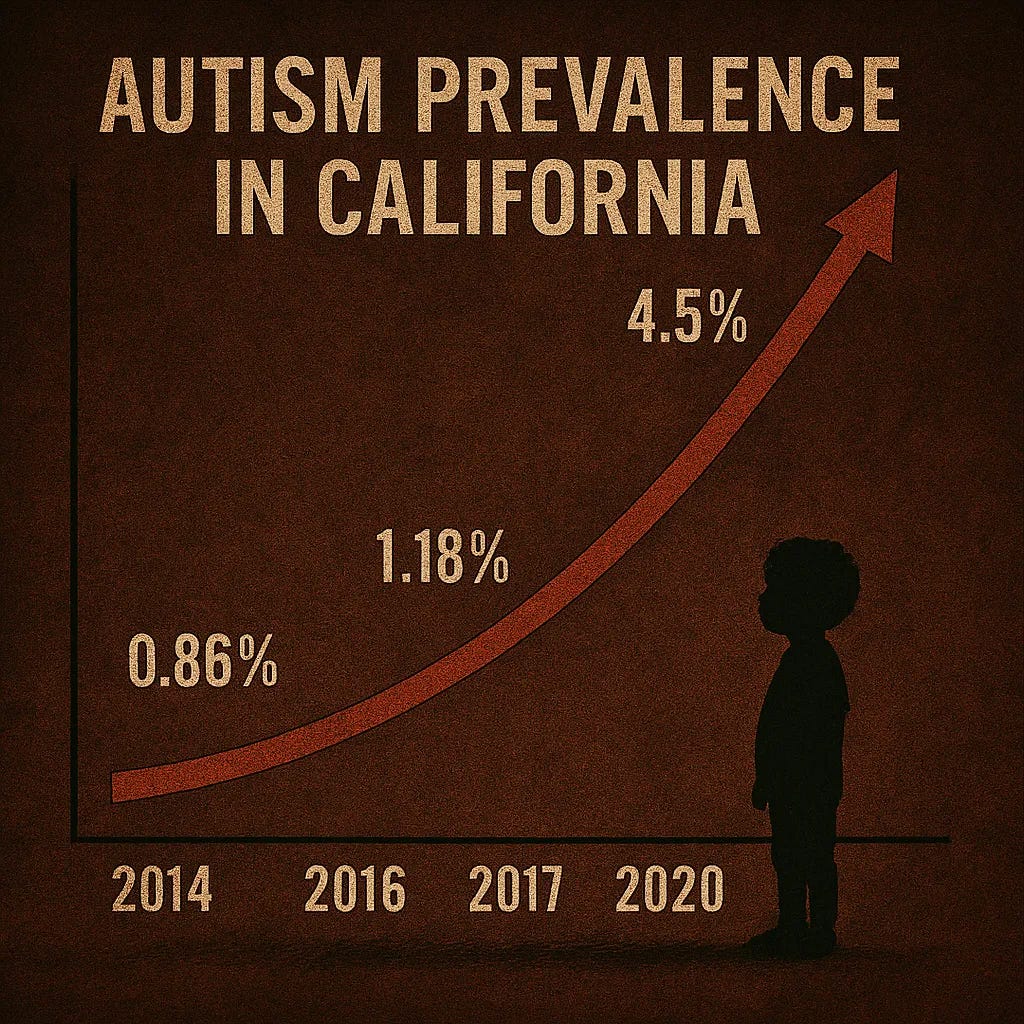Yesterday our community heard the sobering news that rates of autism amongst children living in America have gone up again. Amongst 8 year-olds, the rate was as high as 1 in 31 in 2022 (a figure that is already 3 years out-of-date). Due to sex differences in susceptibility and severity, this equates to 1 in every 19 boys. California was found to have the highest rates of all (4.5%) with non-white populations suffering most.
The data released included information about the cognitive ability of 60% of the 8 year olds reported in the series, and as many as 65% of these children had an intellectual disability, the majority of which was severe.
Perhaps most troubling of all, the data collated for 4 year-old children, available in 13 of the 15 study sites, revealed a yet higher incidence rate, even though you would expect to find additional undiagnosed children in these populations, pending their assessment after starting at school. The data suggest that rates might more than double as these cohorts are picked up again in future reports.
When our son was diagnosed in early 2008, he was 4 and a half years old, and the official autism rate in America was 1 in 150, or 1 in 92 boys. It is now three times higher and looks set to get higher still.
As James Lyons-Weiler wrote yesterday in his newsletter Popular Rationalism: “it appears we are witnessing a real increase in biologically significant, disabling neurodevelopmental injury.”
However, as Anne Dachel put it in her reflection on the data yesterday, these reports have been published for more than a decade. Each report has revealed a higher rate and the ‘experts’ are wheeled out by the media to tell us that this is all about: (1) increased awareness (which is very welcome and reflects a push for equity in access to diagnosis across the population); and/or (2) better expertise in identifying the condition (which is also welcome because it means people will get the help and assistance they need); and/or (3) a kinder society that welcomes full-spectrum recognition and diagnosis of the socially-disabled but brilliant savants who were overlooked in the past (which is also welcome because we are being nice to the people we need to work in IT).
Society is argued to be so much fairer and kinder and more inclusive than it was in the past. We have autism because we are more aware of it, nicer about it and recognise its value to society. Never mind that 1 in every 10 black boys in California is now disabled for life, with knock-on effects for his family, community and the wider society. It is likely that such a child will never be able to make his own way in the world, nurture his own family, pay taxes, build a business, serve his church and even fight for his country. He will likely need support for the rest of his life. Society will be paying for the cost of his disability at school, in social care, in benefits and in unpaid taxes and the lost social contributions he would have otherwise made.
The experts have pedalled Autism Denial Syndrome (ADS) year after year. The same comforting platitudes are repeated on both sides of the pond.
To our shame, however, the UK doesn’t even have up-to-date information about the prevalence of autism. There is a quarterly series for Northern Ireland (NI), drawing on data from the school census and published by the Department of Health in NI, showing a rate of 5% (1 in 20) of children aged 4-15 in the year 2022-23. However, there is no equivalent for the other nations of the UK.
The National Health Service (NHS) is famous for having more bureaucrats than nurses and for employing almost as many people as the Red Army in China, but it hasn’t managed to produce equivalent data to those published for America. Even our national charity, The National Autistic Society (NAS) shares out-of-date rates of 1% despite knowing that the prevalence amongst young people is much higher than this.
Elizabeth O’Nions and colleagues have recently used data collected by General Practitioners to identify shockingly high levels of autism amongst children, but they used this as a springboard for finding the ‘missing adults’ rather than addressing the rates in our youth. As the abstract for the published paper put it: “As of 2018, 2.94% of 10- to 14-year-olds had a diagnosis (1 in 34), vs. 0.02% aged 70+ (1 in 6000). Exploratory projections based on these data suggest that, as of 2018, 463,500 people (0.82% of the English population) may have been diagnosed autistic, and between 435,700 and 1,197,300 may be autistic and undiagnosed (59-72% of autistic people, 0.77%-2.12% of the English population)”.
In this case, experts have justified spending time and resources chasing fictional cases rather than attending to the real cases found in every school and community. It seems a remarkable thing to be doing. Fiddling while Rome burns to the ground.
I am writing this instalment of the Autism Tribune on the day before Maundy Thursday when we remember the last supper, the night when Jesus sat down to eat and drink with his disciples for the very last time. Following the meal, Judas betrayed Jesus to the Romans in the Garden of Gethsemane. We are told he did this for 30 pieces of silver, and he later killed himself in remorse. It was also the night when Jesus predicted that Peter – his most beloved disciple - would deny him three times before the cock crowed the next morning. After Jesus' arrest, Peter, fearing for his own safety, did exactly this. When he heard the cock crow the third time, he remembered Jesus’s words and wept. He felt shame, guilt and remorse. He knew he was weak. As Matthew’s gospel tells us in Chapter 26, verse 75: “Peter remembered the word of Jesus, which said unto him, ‘Before the cock crow, thou shalt deny me thrice’. And he went out and wept bitterly.”
Peter’s Denial by Anton Robert Leinweber
Thinking about the crucifixion 2000 years ago helps me to make sense of Autism Denial Syndrome and why it persists. The human story has always been about powerful people setting the agenda and silencing those who would challenge their throne. The academic and policy experts are employed to repeat the platitudes and would only damage their careers, income and security by rocking the boat. The hiring committees, peer reviewers and publishing houses only have space for ‘their own’. Mavericks have been squeezed out of the system just when we needed them most. The experts’ denial through fear reflects Peter’s actions in denying Christ. Their denial through compliance reflects Judas’s actions in taking the money. The suffering of our children reflects the collective sin of the system that allows this to happen. We haven’t had the strong leadership and collective strength to speak out, until now. Maybe it’s just me, but I feel that the tectonic plates of autism denial are moving – even on this side of the Atlantic.
Autism Denial Syndrome is harming our children and the wider society. It is normalising neurological damage on a scale hitherto only imagined in Sci-fi books and films. It is no longer credible to say that autism is benign and nothing to worry about, that the numbers are real but of no real importance. As I know only too well through personal heartache, each diagnosis reflects a real child whose parents are struggling to support them, whose siblings have a very different life to the one that would otherwise be, whose school and community have to try and adapt, and whose society covers the cost.
This Easter is the perfect time to reflect and renew our resolve to speak out, to tell our story and to make the numbers as real as they are. Our children have been made a living sacrifice to the Gods of progress, profit and professional group-think. Next Easter there may have been a reckoning with this and however imperfectly, new stories may be told, even by the experts who pedal denials today. Despite his betrayal and crucifixion, Christ lived on in the human story and our children are testimony to the truth that will similarly never die. Our day will come. Believe me. And if you live in the UK, join me to be ready - and I will add more information to the subscribers’ chat about this. Happy Easter to you all.








The National Autistic Society is made up of those who would have formally been diagnosed with Asperger's, under DSMIV. A very different condition where to be diagnosed intelligence and speech had to be normal.
Asperger's was usually recognised and diagnosed in the teen years, so has little impact on autism CDC figures that are in 8 years olds, who usually have the old disabling autism, since the logic being the younger you are at being spotted and diagnosed the worse the autism, it being more likely autism not the more functioning Asperger's.
They were merged together as two separate conditions to make it deliberately harder for science to find the cause of what is now Autism, i.e. the coverup. Since merging two different separate conditions would naturally corrupt any causation data, unfortunately this also extends into autism drug trials that have all failed for this very reason.
Those with Asperger's were then sold into the idea of Neurodiversity and identity politics, loudly being anti cure and finally conveniently anti autism research.
This was largely pushed and funded by those who want to cover up what`s going on, telling neurotic people what they always wanted to hear, that others and society are to blame for their failures rather than their own brain, also forsaking those who had the original disabling autism rather than the new more neurotic ASD. Those with the old increasing autism became buried under a mountain of almost normal people including celebrities proclaiming they have autism.
So, no I wouldn’t expect anything of value from any so called Autism group unless it was run by the parents themselves.
We also need to count the cost to society in cash terms. My son has a triple diagnosis of DS, ASD and T1 Diabetes, he is 30 and lives in his lovely terraced house in a quiet village. We/He employs 6 members of staff through a direct payment at a cost to the Local Authority of £150k, and he claims top rate welfare benefits of around £25k. Add the medical costs and it rises.